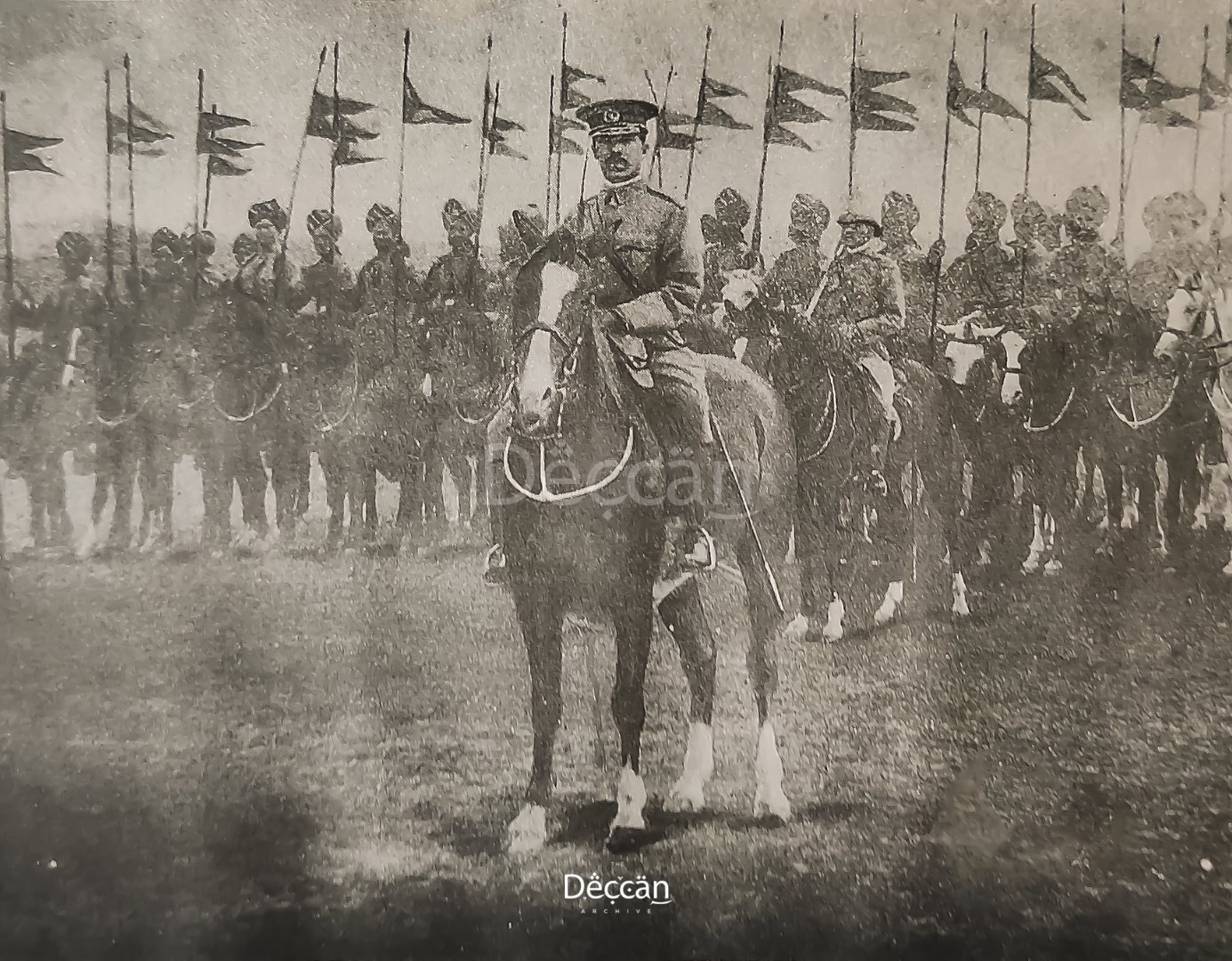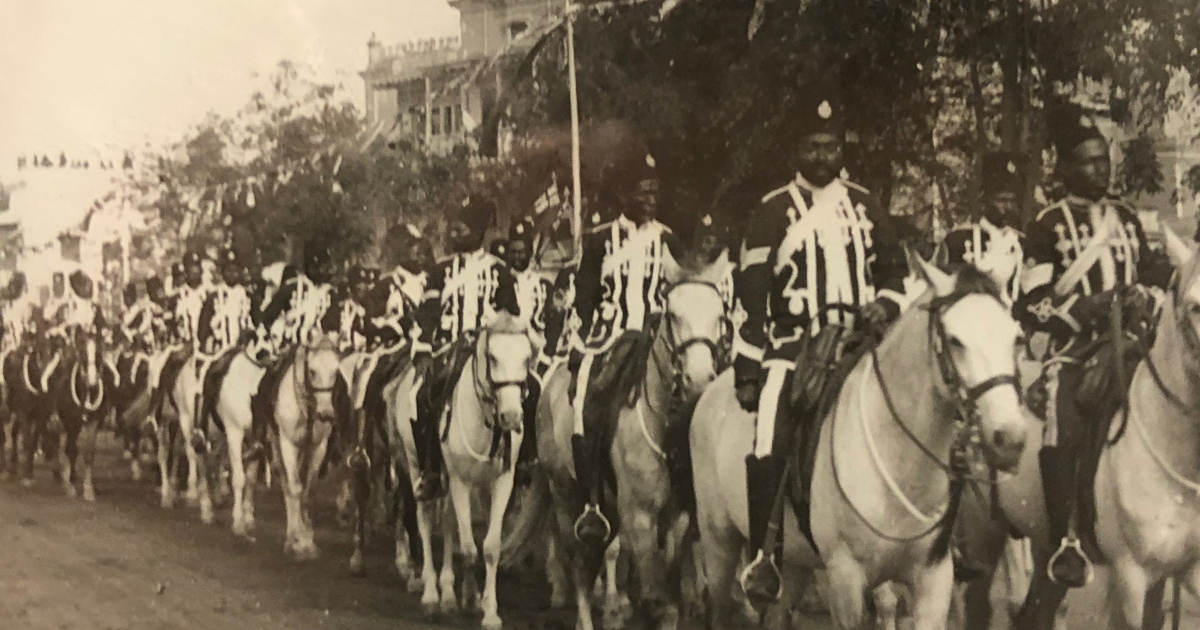Hyderabad State Forces on:
[Wikipedia]
[Google]
[Amazon]
The Hyderabad State Forces were the armed forces of the


 Actually It was Three different corps were commanded by three different independent commanders. The
Actually It was Three different corps were commanded by three different independent commanders. The
Soldiers of NIZAMS of HYDERABAD STATE
princely state
A princely state (also called native state or Indian state) was a nominally sovereign entity of the British Raj, British Indian Empire that was not directly governed by the British, but rather by an Indian ruler under a form of indirect rule, ...
of Hyderabad
Hyderabad ( ; , ) is the capital and largest city of the Indian state of Telangana and the ''de jure'' capital of Andhra Pradesh. It occupies on the Deccan Plateau along the banks of the Musi River (India), Musi River, in the northern part ...
. People from both India and abroad were recruited into the Forces. Among these groups were Arab nationals like Chaush and African nationals like Siddi's who now stay in Barkas and A.C. Guards areas of present Hyderabad respectively. The Hyderabad cavalry was chiefly composed of Muslim castes such as Mughals, Pathans, Syeds, Sheikhs and Balochs.
Afghan And Pathan's Are joined militry who are migrated from present day Afghanistan,pakistan and Kashmir.They were principally recruited from the Deccan
The large Deccan Plateau in South India, southern India is located between the Western Ghats and the Eastern Ghats, and is loosely defined as the peninsular region between these ranges that is south of the Narmada river. To the north, it is bou ...
, but Delhi
Delhi, officially the National Capital Territory (NCT) of Delhi, is a city and a union territory of India containing New Delhi, the capital of India. Straddling the Yamuna river, primarily its western or right bank, Delhi shares borders w ...
, Lucknow
Lucknow (, ) is the capital and the largest city of the Indian state of Uttar Pradesh and it is also the second largest urban agglomeration in Uttar Pradesh. Lucknow is the administrative headquarters of the eponymous district and division ...
, Shahjahanpur
Shahjahanpur () is a municipal corporation, town and district headquarters of Shahjahanpur District in Uttar Pradesh, India.
The city is between Bareilly and Lucknow, the capital of Uttar Pradesh.
History
Shahjahanpur was established by Dil ...
, Sindh
Sindh (; ; ur, , ; historically romanized as Sind) is one of the four provinces of Pakistan. Located in the southeastern region of the country, Sindh is the third-largest province of Pakistan by land area and the second-largest province ...
and Balochistan
Balochistan ( ; bal, بلۏچستان; also romanised as Baluchistan and Baluchestan) is a historical region in Western and South Asia, located in the Iranian plateau's far southeast and bordering the Indian Plate and the Arabian Sea coastline. ...
also supplied recruits to bolster ranks. These non-indigenous soldiers were called as "Rohollas". The Hindus made a very small portion of the cavalry. The Nizam of Hyderabad
The Nizams were the rulers of Hyderabad from the 18th through the 20th century. Nizam of Hyderabad (Niẓām ul-Mulk, also known as Asaf Jah) was the title of the monarch of the Hyderabad State ( divided between the state of Telangana, Mar ...
also had about 1200 Sikh
Sikhs ( or ; pa, ਸਿੱਖ, ' ) are people who adhere to Sikhism, Sikhism (Sikhi), a Monotheism, monotheistic religion that originated in the late 15th century in the Punjab region of the Indian subcontinent, based on the revelation of Gu ...
guards. Other battalions within the army were called line "Walas". Some troops were also supplied by Europeans for the security of Nizam.
Commanding Divisions


 Actually It was Three different corps were commanded by three different independent commanders. The
Actually It was Three different corps were commanded by three different independent commanders. The Nizam
The Nizams were the rulers of Hyderabad from the 18th through the 20th century. Nizam of Hyderabad (Niẓām ul-Mulk, also known as Asaf Jah) was the title of the monarch of the Hyderabad State ( divided between the state of Telangana, Mar ...
, the Diwan, and an important officer in Nizam's government called Shangal Umara or "Amin Kabir" each one maintained their own separate divisions.
During the time of Operation Polo, the Hyderabad State Forces consisted of six infantry battalions, two Cavalry regiments, and 1,500 armed irregulars. The army had two light armored regiments and one field battery. In total, the Nizam's army numbered 24,000 men, of whom some 6,000 were fully trained and equipped. Some of the units surrendered on the first two days of the Operation. Four Hyderabadi infantry Companies and three Cavalry squadrons were later absorbed into the Maratha Light Infantry
The Maratha Light Infantry is a light infantry regiment of the Indian Army. It traces its lineage to the Bombay Sepoys, raised in 1768, making it the most senior light infantry regiment in the Indian Army. The class composition of the regiment ...
, Madras Regiment
The Madras Regiment is the oldest infantry regiment of the Indian Army, originating in the 1750s. The regiment took part in numerous campaigns with both the British Indian Army and the post-independence Indian Army.
History
The town of Madras wa ...
, Poona Horse
The Poona Horse is an armoured regiment in the Armoured Corps of the Indian Army. The regiment, known before independence as The Poona Horse (17th Queen Victoria's Own Cavalry), was raised as a regular cavalry regiment in the Bombay Presidency a ...
and Deccan Horse
The Deccan Horse or 9 Horse is one of the oldest and most decorated armoured regiments of the Indian Army. The Royal Deccan Horse (9th Horse), which was a regular cavalry regiment of the British Indian Army was formed from the amalgamation of tw ...
of the Indian Army respectively.
History
British Rule
In 1767-1768, Nizam ʿĀlī accepted British Suzerainty on Hyderabad state through theTreaty of Masulipatam
The Northern Circars (also spelt Sarkars) was a division of British India's Madras Presidency. It consisted of a narrow slip of territory lying along the western side of the Bay of Bengal from 15° 40′ to 20° 17′ north latitude, in the pre ...
. From 1778 onwards, a British resident
Resident may refer to:
People and functions
* Resident minister, a representative of a government in a foreign country
* Resident (medicine), a stage of postgraduate medical training
* Resident (pharmacy), a stage of postgraduate pharmaceuti ...
and subsidiary force were installed in his dominions. His state surrounded by areas controlled by the British, Nizam ʿĀlī Khan, Asaf Jah 2 was pushed to enter into an agreement that placed his country under British protection in 1798.
Nizam ʿĀlī Khan and his soldiers were fought for the British in the Second
The second (symbol: s) is the unit of time in the International System of Units (SI), historically defined as of a day – this factor derived from the division of the day first into 24 hours, then to 60 minutes and finally to 60 seconds ...
(1803–05) and Third
Third or 3rd may refer to:
Numbers
* 3rd, the ordinal form of the cardinal number 3
* , a fraction of one third
* Second#Sexagesimal divisions of calendar time and day, 1⁄60 of a ''second'', or 1⁄3600 of a ''minute''
Places
* 3rd Street (d ...
(1817–19) Maratha Wars, and Nizam Nāṣir al-Dawlah and Hyderabad's military contingent remained loyal to the British during the Sepoy Mutiny
The Indian Rebellion of 1857 was a major uprising in India in 1857–58 against the rule of the British East India Company, which functioned as a sovereign power on behalf of the British Crown. The rebellion began on 10 May 1857 in the for ...
(1857–58).
Operation Polo
In September 1948, theIndian Army
The Indian Army is the land-based branch and the largest component of the Indian Armed Forces. The President of India is the Supreme Commander of the Indian Army, and its professional head is the Chief of Army Staff (COAS), who is a four- ...
invaded Hyderabad State
Hyderabad State () was a princely state located in the south-central Deccan region of India with its capital at the city of Hyderabad. It is now divided into the present-day state of Telangana, the Kalyana-Karnataka region of Karnataka, and t ...
. The battle between the Nizam's army and the Indian army had lasted for five days, and had led to an Indian victory. On Day 5 of this operation - 17 September 1948, the 7th Nizam announced a ceasefire which ended the armed action. As a result of this, Hyderabad was integrated into the Indian union
See also
*Annexation of Hyderabad
Operation Polo was the code name of the Hyderabad "police action" in September 1948, by the then newly independent Dominion of India against Hyderabad State. It was a military operation in which the Indian Armed Forces invaded the Nizam-ruled ...
* Imperial Service Troops
The Imperial Service Troops were forces raised by the princely states of the British Indian Empire. These troops were available for service alongside the Indian Army when such service was requested by the British government. At the beginning of ...
* 15th (Imperial Service) Cavalry Brigade
The 15th (Imperial Service) Cavalry Brigade was a brigade-sized formation that served alongside British Empire forces in the Sinai and Palestine Campaign, during World War I. Originally called the Imperial Service Cavalry Brigade it was formed ...
External links
Soldiers of NIZAMS of HYDERABAD STATE
References
{{Use dmy dates, date=March 2017 * History of Hyderabad, India Military units and formations of the princely states of India Military units and formations established in 1724 Military units and formations disestablished in 1948